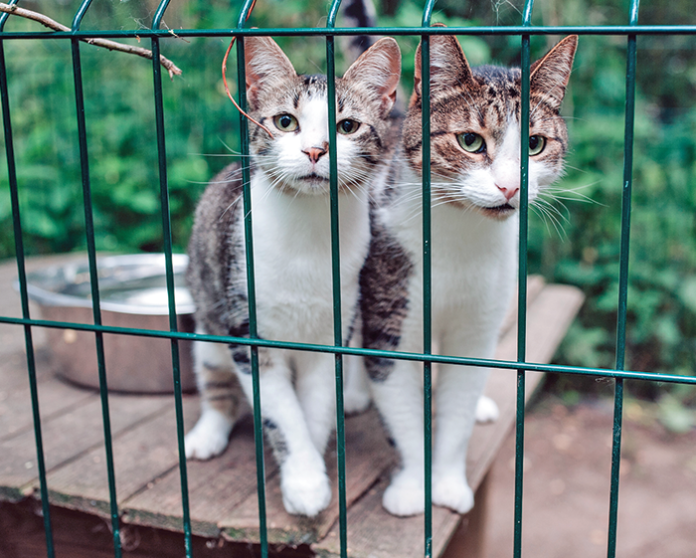All cat lovers understand the perils of letting a cat run outside: traffic, wild animals, other domestic animals, unscrupulous people, and disease. But we also watch our cat look longingly out the window, clearly wishing for a taste of freedom. We may think he’s bored or that we need to increase his exercise. The solution may be found in a catio.
A catio is a term derived from the phrase “patio for cats.” It’s a fully enclosed area—all sides, a roof, and floor or secured base—that a cat cannot possibly escape from and that no animal can invade. The catio must be sturdy and secure. From there, you can let your imagination run wild.
“A catio addresses some of the major health risks to cats during the warm summer months,” advises Elizabeth, Cornell’s Feline Health Center resident cat and our back-page columnist. “Cats are let out in an unsupervised fashion more during the warmer months (a practice that we do not endorse), exposing them to the risks of being hit by a car or getting into fights with other cats or animals. Such encounters increase the risk of health problems ranging from infectious diseases to life-threatening or even fatal injuries,” she says. “A catio can help prevent these problems.”
Location
Choose your spot carefully. You will need to be able to safely bring your cat out and in without him trying to escape. Some catios are built with a direct door or window entrance, so the cat is never out of an enclosure. If you rent your home, you will need to discuss the location and the structure with your landlord. It’s a good idea, even if you own your home, to check with your town’s coding office to ensure there are no laws that might restrict your design.
Look for a spot that will give the cat both shade and sun. If you’re building a window catio, will your cat be able to go in and out as he pleases to escape the strong sun? If not, you will have to restrict the times he is in it. Never leave your cat in a catio when you are not home, as accidents can always happen.
Consider your flooring options. Popular choices include wood (like deck flooring), gravel or stone, mulch, and grass. If you choose grass, be sure you’ll be able to easily get in and out to cut the grass when it gets too long. The other options are low maintenance, but they will need occasional upkeep.
Building Considerations
Depending upon your preferences, your catio may include a solid roof, which will usually take care of the shade consideration and allow your cat to be outside when it rains. Since this is a semi-permanent structure, you need to be sure the roof can handle snow loads in your area. Your coding office can help you with roof pitch, so more snow slides off rather than building up. If you choose a metal roof, be sure you place insulation under it to stop dripping from condensation. While a wire mesh roof eliminates problems with condensation, it can still allow snow to build up, especially if it’s a flat roof.
Since you want your cat to experience as much of the outside as possible, your best choice for walls is a wire mesh. Avoid chicken wire as it isn’t strong and can have rough edges. A 2- x 3-inch wire mesh (sometimes called no-climb) is better. We recommend 16-gauge wire or stronger. (The lower the gauge the stronger the wire.)
Amenities
Cats like to perch, so include plenty of spots to climb and look around. Large rocks, ramps, tunnels, and cat trees are all good choices. One structure we saw had a ramp to the window of the house, so the cat could come and go as he pleased.
As you’re looking at structures—there is an amazing array of commercially available catios—keep in mind that you need to avoid anything that a collar may get caught on, if your cat wears one. This can be extremely dangerous. Better yet, consider removing the collar unless you’re right there with him. Many catios are built with a bench or room for a chair for humans.
Consider spots for a scratching post, even a real piece of wood like a large branch or piece of firewood. You will need to include a litterbox, perhaps placed in the most private corner of the catio. Cat-safe plants like fresh catnip will be enjoyed as well. A water bowl is a necessity as well, but food isn’t.
Be aware that your all-indoor cat who never showed interest in what lies beyond the door may change his mind when he gets a taste of outdoor living in a catio. Keep in mind that he may begin to play the “door dash” game, trying to escape when you open the door to pick up the paper or greet a guest.
If you’re not a do-it-yourselfer, you can purchase a catio online (costs range from around $300 on up) or purchase a simple dog kennel kit and make small changes to make it safe for a cat, adding some climbing and perching options. If you’re looking for ideas, we found an amazing array of photos of catio designs at www.pinterest.com/arlinegrant/catio. Let your imagination run wild!
What You Should Know
Concerns arise with outdoor activity
- Contact with other cats through the wire is possible. Be sure your cat is properly vaccinated by discussing your plan with your veterinarian.
- Infestation with fleas, ticks, mites, a variety of intestinal worms, and other nasty little critters such as heartworms becomes more likely.
- Watch the weather. Even with shade, high temperatures increase the risk for dehydration and heat exhaustion/stroke (lethargy, vomiting, staggering, rapid/heavy breathing, red tongue/mouth). Sunburn can occur, especially with white cats.
- Extreme cold weather and snow can open the door for frostbite. If your cat doesn’t want to venture out in the wet stuff, don’t force the issue.




